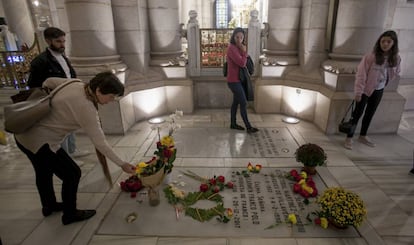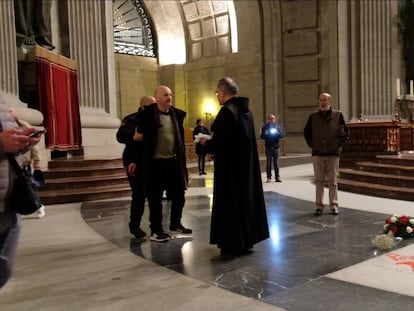Security reasons cited to prevent reburial of Franco in Madrid cathedral
The Socialist Party government is trying to stop the former dictator from being moved to the center of Madrid, in line with his family’s wishes

The Spanish government is starting to see the light at the end of the tunnel in the long process of exhuming the remains of former dictator Francisco Franco from the Valley of the Fallen monument, located around 60 kilometers from the center of Madrid. A 12-page report from the central government’s delegate in Madrid concludes that the body must not be interred in La Almudena cathedral, as Franco’s family wants, on reasons of public order, the risk of terrorist threats, and the possibility of confrontations between supporters and detractors in the crypt itself, a holy site where the police would not be able to enter.
The document will be used by the government of Socialist Party (PSOE) Prime Minister Pedro Sánchez to reject the requests of the Franco family to use their crypt in the cathedral as Franco’s resting place, a move that threatened to make a mockery of the plan to move the dictator’s remains, given the central location of La Almudena, in the heart of one of Madrid’s main tourist districts.
The government has opted for a direct route, one that focuses on the defense of the fundamental rights of citizens
The move was one of Sánchez’s star policies when he came to power in June, but since July the government has been forced to maneuver in order to deal with the opposition to the plan by the Franco family, which is fiercely opposed to their grandfather being removed from the Valley of the Fallen, and has been taking advice from top lawyers as to how to stop the process.
When the Franco family realized that they could not avoid the exhumation, they instead demanded the body be reburied in La Almudena, next to the grave of his daughter, Carmen Polo. The government decided that it could not let this happen under any circumstances – no European dictator currently rests in a Cathedral.
In response, Deputy Prime Minister Carmen Calvo even traveled to Rome to address the issue in the Vatican with Pietro Parolin, the pope’s right-hand man. The government also sought to block the move by amending the Historical Memory Law, but this was not possible due to the opposition of other parties.
For now an alternative burial site has not been proposed, and the Franco family is unlikely to suggest one
In the end the government has opted for a direct route, one that focuses on the defense of the fundamental rights of citizens in order to stop the remains being moved to La Almudena.
The report points out that in 2018 a total of 366,000 people visited Franco’s grave in the Valley of the Fallen. The government believes that this number would only rise if the former dictator was in a more central location, especially on key dates such as November 20, the day of his death.
The report also points to an increased risk of conflict, citing ugly scenes that took place on November 18 of this year between Franco supporters who were demonstrating in the center of Madrid, and activists from the feminist group Femen.
For now an alternative burial site has not been proposed, and the Franco family is unlikely to suggest one. In that case, the government will decide on the site, and the most probable option at the moment is the Mingorrubio cemetery, where the dictator’s wife is buried.
The reports will now be passed to the family and the other concerned parties in this process, who will have 10 days to respond. Then the Cabinet will take a final decision, and Franco will be exhumed – assuming the Supreme Court does not object. But this is something that the government, which has closely examined all the legal aspects of the process, does not believe will happen.
English version by Simon Hunter.
Tu suscripción se está usando en otro dispositivo
¿Quieres añadir otro usuario a tu suscripción?
Si continúas leyendo en este dispositivo, no se podrá leer en el otro.
FlechaTu suscripción se está usando en otro dispositivo y solo puedes acceder a EL PAÍS desde un dispositivo a la vez.
Si quieres compartir tu cuenta, cambia tu suscripción a la modalidad Premium, así podrás añadir otro usuario. Cada uno accederá con su propia cuenta de email, lo que os permitirá personalizar vuestra experiencia en EL PAÍS.
¿Tienes una suscripción de empresa? Accede aquí para contratar más cuentas.
En el caso de no saber quién está usando tu cuenta, te recomendamos cambiar tu contraseña aquí.
Si decides continuar compartiendo tu cuenta, este mensaje se mostrará en tu dispositivo y en el de la otra persona que está usando tu cuenta de forma indefinida, afectando a tu experiencia de lectura. Puedes consultar aquí los términos y condiciones de la suscripción digital.
More information
Archived In
Últimas noticias
The complicated life of Francesca Albanese: A rising figure in Italy but barred from every bank by Trump’s sanctions
Half of Scotland is in the hands of 420 property owners
Pinochet’s victims grapple with José Antonio Kast’s rise in Chile
Reinhard Genzel, Nobel laureate in physics: ‘One-minute videos will never give you the truth’
Most viewed
- Pablo Escobar’s hippos: A serious environmental problem, 40 years on
- Why we lost the habit of sleeping in two segments and how that changed our sense of time
- Charles Dubouloz, mountaineering star, retires at 36 with a farewell tour inspired by Walter Bonatti
- Reinhard Genzel, Nobel laureate in physics: ‘One-minute videos will never give you the truth’
- The Florida Keys tourist paradise is besieged by immigration agents: ‘We’ve never seen anything like this’











































